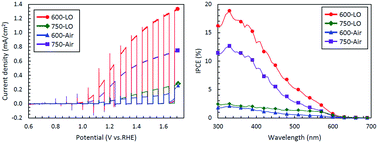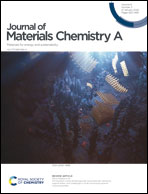Effects of low oxygen annealing on the photoelectrochemical water splitting properties of α-Fe2O3†
Abstract
Photoelectrochemical (PEC) water splitting is a promising method for converting solar energy into chemical energy stored in the form of hydrogen. Nanostructured hematite (α-Fe2O3) is one of the most attractive materials for highly efficient charge carrier generation and collection, due to its large specific surface area and shortened minority carrier diffusion length required to reach the surface. In the present work, PEC water splitting performance of α-Fe2O3 prepared by anodization of thin iron layers on FTO glass and subsequent annealing in a low O2–Ar atmosphere with only 0.03% O2 was investigated. The key finding is that annealing anodic nanostructures with a low oxygen concentration provides a strongly enhanced PEC performance compared with classical air annealing. The photocurrent of the former at 1.5 V vs. RHE results in 1.1 mA cm−2, being 11 times higher than that of the latter. The enhancement of the PEC performance of α-Fe2O3 annealed in a low oxygen atmosphere can be attributed to the controlled morphology, Sn doping, and introduction of oxygen vacancies, which contribute to the enhancement of the hole flux from the photogenerated site to the reactive surface and additionally lead to an enhanced hole transfer at the interface between α-Fe2O3 and the electrolyte. From the obtained results, it is evident that low oxygen annealing is a surprisingly effective method of defect engineering and optimizing α-Fe2O3 electrodes for a maximized PEC water splitting performance.



 Please wait while we load your content...
Please wait while we load your content...